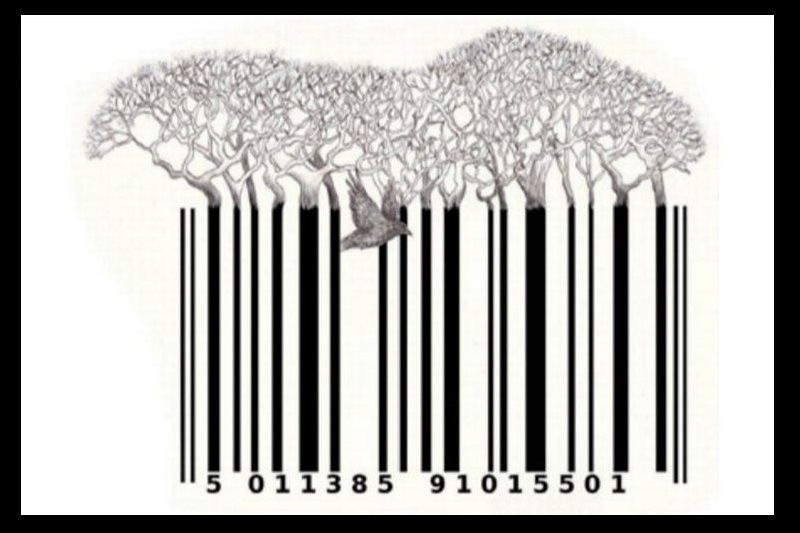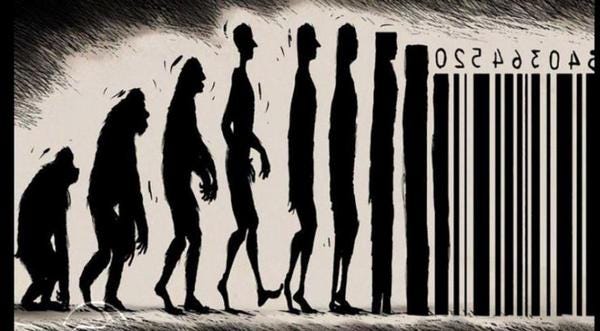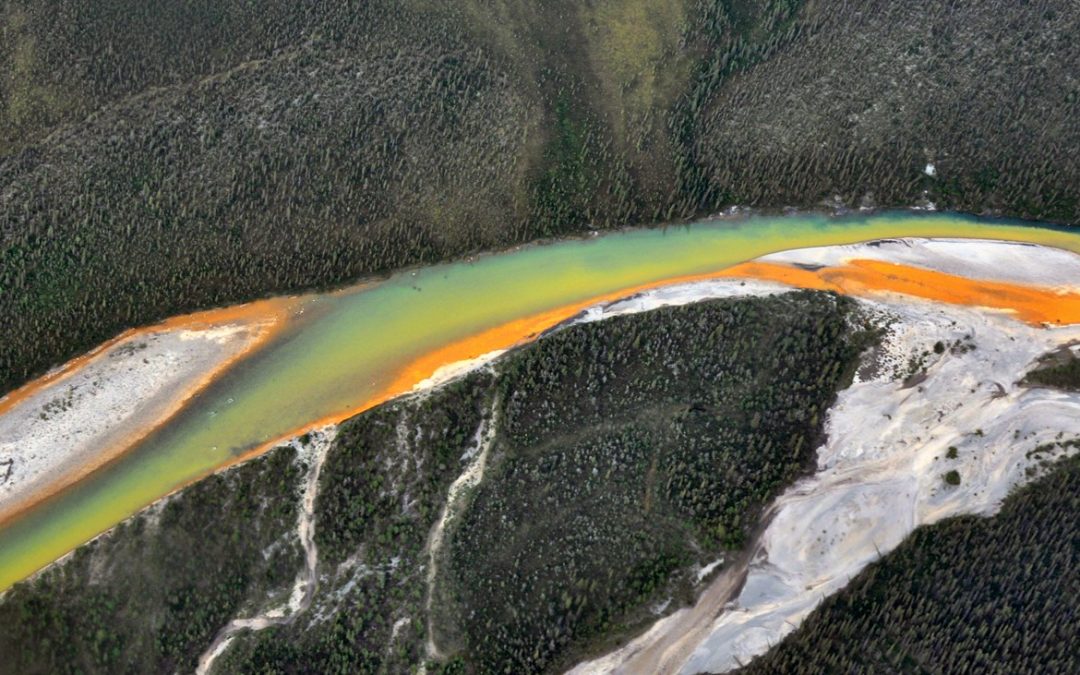By Liz Kimbrough / Mongabay
Dozens of once-pristine rivers and streams in Alaska’s Brooks Range are turning an alarming shade of orange. The discoloration, according to a new study published in the journal Communications Earth and Environment, is likely caused by the thawing of permafrost, which is exposing previously frozen minerals that are now leaching into the waterways.
The research team, led by ecologist Jon O’Donnell from the U.S. National Park Service, documented 75 locations across a vast area of northern Alaska where the crystal-clear waters now appear heavily stained. Using satellite imagery and field observations, the scientists determined that the onset of this discoloration coincided with a period of warming and increased snowfall in the region over the past decade.
Permafrost, which is ground that remains frozen year-round, acts as a storage vault for various minerals. As rising temperatures cause this frozen layer to thaw, these minerals are exposed to water and oxygen, triggering chemical reactions that release iron and other metals into the groundwater. This metal-rich water then makes its way into rivers and streams.
“Our recent study highlights an unforeseen consequence of climate change on Arctic rivers,” study co-author Brett Poulin, an environmental toxicologist from the University of California, Davis, told Mongabay. “Arctic environments are warming up to four times faster than the globe as a whole, and this is resulting in deterioration of water quality in the most pristine rivers in North America.”
 Map of orange stream observations across Arctic Inventory and Monitoring Network (ARCN) parks in northern Alaska. Picture inserts show aerial images of select iron-impacted, orange streams. Map created by Carson Baughman, U.S. Geological Survey. Photos by Kenneth Hill, National Park Service. Public domain.
Map of orange stream observations across Arctic Inventory and Monitoring Network (ARCN) parks in northern Alaska. Picture inserts show aerial images of select iron-impacted, orange streams. Map created by Carson Baughman, U.S. Geological Survey. Photos by Kenneth Hill, National Park Service. Public domain.
 Impacts of iron mobilization in a stream tributary of the Akillik River located in Kobuk Valley National Park, Alaska. These images were taken two years apart. The clear picture was taken in June 2016 and the orange picture was August 2018. Photos by Jon O’Donnell, National Park Service.
Impacts of iron mobilization in a stream tributary of the Akillik River located in Kobuk Valley National Park, Alaska. These images were taken two years apart. The clear picture was taken in June 2016 and the orange picture was August 2018. Photos by Jon O’Donnell, National Park Service.
Water samples collected from the affected streams revealed lower pH levels and higher concentrations of sulfates and trace metals compared to nearby unaffected waterways. In some cases, the pH levels dropped to 2.3, similar to the acidity of vinegar. The presence of elevated levels of iron, zinc, nickel and copper is the primary cause of the color change.
The ecological consequences of this phenomenon could be significant. At one site in Kobuk Valley National Park, researchers observed the disappearance of fish species and a decline in aquatic insect diversity shortly after the appearance of orange water. Juvenile Dolly Varden trout (Salvelinus malma) and slimy sculpin (Cottus cognatus) were among the fish species that vanished from the stream.
“Many of these affected streams serve as important spawning grounds and nurseries for salmon and other fish species that are crucial to the ecosystem and local subsistence fisheries,” study co-author Michael Carey, a fisheries biologist with the U.S. Geological Survey, said in a statement. “Changes in water quality could have effects throughout the food web.”
Human communities in the region also rely on these rivers and streams for their drinking water supply and subsistence fishing. As permafrost thaw accelerates and more minerals are released into the waterways, the safety and reliability of these resources could be impacted. Poulin emphasized the need for further research to understand the long-term implications for humans.

“Our larger research effort aims to identify where the minerals are located that are the source of the metals and identify which rivers are most sensitive,” Poulin said. “With those two pieces of information, we will be able to accurately assess risk to the ecosystem and humans.”
Poulin also highlighted the uniqueness of these observations, noting that while gradual changes in water quality due to permafrost thaw have been documented in other parts of the Arctic and in high elevations of the Rockies and European Alps, the abrupt changes in water chemistry seen in the Brooks Range are particularly concerning.
“The rivers impacted by this phenomenon span the length of the Brooks Range” — about 1,100 kilometers, or 680 miles — “and involve some of the most pristine rivers in North America that are in protected lands and far from mining sources,” Poulin said.
As scientists work to better understand the complex interactions between thawing permafrost, mineral release and aquatic ecosystems, the study underscores the far-reaching consequences of climate change in the Arctic.
Banner image satellite imagery by Ken Hill, U.S. National Park Service.
Liz Kimbrough is a staff journalist for Mongabay. She has written about science and environmental issues since 2012 and holds a Ph.D. in Ecology and Evolutionary Biology from Tulane University where she studied the microbiomes of trees.
the commodification machine
By Mankh / Musings from Between the Lines
“commodify” from modus “measure”
“Number is as fundamental as the other three cardinal metaphors,
space, time, and matter because it is an interrelated aspect of the
divide-and-conquer metaphor which extends and diversifies the primal unity.” – Roger S. Jones, from Physics As Metaphor

where’s the pleasure
when everything’s measured,
and why isn’t water declared
a national treasure,
because everything’s tallied
by numbers in a ledger
monthly bills with
amounts of water,
oil, natural gas, and electricity
the measurement’s diminishing the felicity
it’s mean (literally)
and pretends to be green
the opposite of grist to the mill,
the commodification machine
the commodification machine
with Midas touch
but what you gonna eat
when you touch your burger
and it’s no longer meat
the selfishness is in the word, “mine”
mine for copper, mine for nickel,
mine for lithium, mine for gold
but alchemy is turning cucumber into pickle
grains of sand
and stars in the sky,
too many to count
but at least the stars
they can’t commodify
where’s the pleasure
when everything’s measured,
why isn’t land declared
a national treasure,
because everything’s tallied
by numbers in a ledger
the destruction and deadly side-effects
of divide-and-conquers
proves that disregarding primal unity
is totally bonkers
raindrops, snowflakes,
blades of grass, wildflowers,
too many to count
even with countless hours
it’s mean (literally)
and pretends to be green
the opposite of grist to the mill,
the commodification machine



We are being told that a few degrees warmer planet would be a horendous disaster, but the climate of the last few centuries has been an anomoly. In the Late Middle Ages the climate was several degrees warmer than it has been since, and in the Climatic Optimum, between 6,000 and 8,000 years ago, there was no pack ice in the Arctic Ocean and the tree line extended right up to the shores of that ocean in both North America and Siberia. Anyone claiming that a warmer earth would be harmful to the biosphere should be asked to explain those facts. In the time period known as the Climatic Optimum, between 6,000 and 8,000 years ago, the tree line extended right up to the shores of the Arctic Ocean in both Canada and Siberia, the coastal shores of Greenland and Anarctica were free of ice, and the shells of warm-water marine organisms have been dredged up from the mud at the bottom of the Arctic Ocean. The climate must have been considerably warmer than it is today All forms of life flourished in the Climatic Optimum Era and almost all would greatly benefit today if the climate returnede to what was normal at that time.
Can Man Change the Climate? : P. Borisov : Free Download …
Borisov wanted to melt the Arctic icecap to warm up Siberia for farming. He had a wrong idea of how to go about doing it, but his study of what the probable benefits would be if it was done remains valid. That shows how wrong the currently popular idea is that a warmer world would be a disaster. In fact, the last time the polls were ice-free, during the Climatic Optimum from 6,000 to 8,000 years ago, was the best time in millions of years for nearly all ecosystems and most species. A return to that climate regime would be one of the best things that could happen to the biosphere of this planet.
But that is not what is happening. Contrary to the hysterical nonsense that the earth is getting warmer, the fact is that it is getting colder on average while becoming more random, chaotic, variable, and unreliable. The German word, Kilimasturtz is the best way to describe what is actually happening to the weather. There is no exact equivelent term in English.
Most forms of life could adapt very well to a warmer habitat, but there is no way to adapt to a random one that varies greatly from day to day. It would be a good thing if the doomsters were right and the earth was getting warmer, but it happens that they are wrong and it is not getting warmer. And what is actually happening is worse than the warming they fear.
Life can adapt to a warmer world or a colder one. Neither alone would be a disaster. But nothing can adapt to a constantly fast changing climate.
If the only change happening was the climate getting warmer, that would be nothing new in world history and nothing to worry about. In fact, a return to the Climatic Optimum, the climate that prevailed between 6,000 and 8,000 years ago, when there were no polar ice caps and the tree line in both Canada and Siberia extended right up to the shores of the Arctic Ocean, would be a very good thing for almost all species, most of which flourished at that time and many of which went into decline or extinction when the current climate took over.
If that ancient climate could be restored many extinct species might return. But what is happening now is not going in that direction.
If you are interested in this issue, read this book.
Can Man Change the Climate? : P. Borisov : Free Download …
The climate changed rather drastically at the end of the Climatic Optimum, around 5,400 years ago, apparently as a result of a meteor storm. What probably happened was the chance encounter with a swarm of meteors that happened to hold a charge almost, but not quite equal to that of the earth resulted in the earth losing a great part of it’s charge in equalizing discharges when the charged earth and the charged meteors came close enough together for giant sparks to jump the gap. The eyewitnesses tell us, “Zeus struck him ( Phaeton ) to earth with a thunderbolt” . That is true, leaving Zeus out of it, of course. The charged meteors triggered strikes of cosmic lightning, thousands of time greater than ordinary thunderstorm lightning. These giant bolts used up most of the planetary charge.
The end result is that today we live on a planet with far less charge than it formerly had. So little charge, in fact, that it is now even possible to touch and handle metal objects without getting a painful shock. That is why right after the Great Discharge, as it might be called, people started to use metal implements, something that was impossible previously. Human cultures went from Neolithic users of stone tools to metal-using as soon as the charge of the planet was reduced enough that they could handle metal without getting a shock.